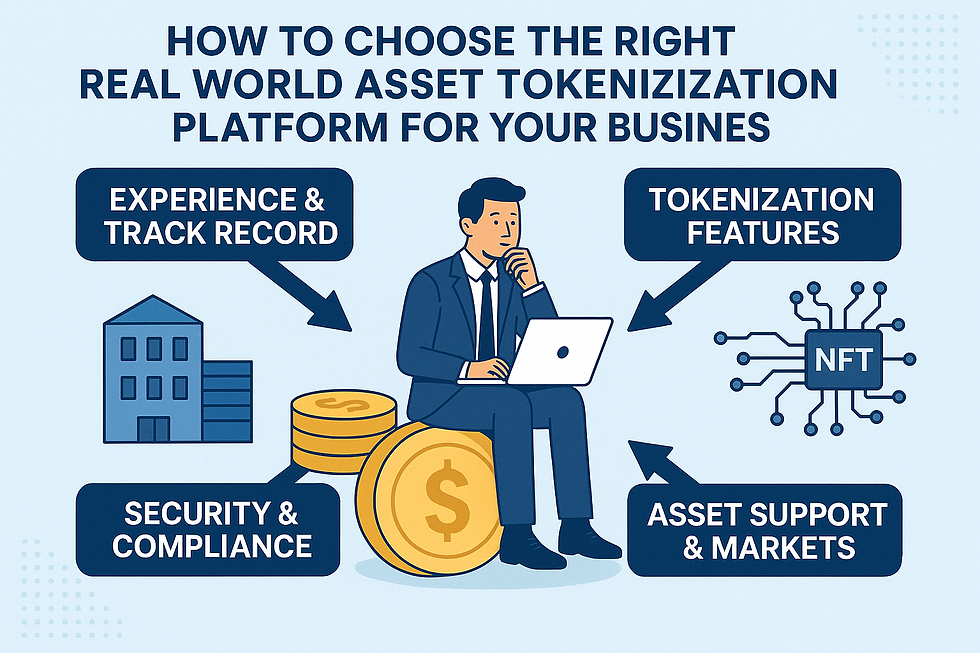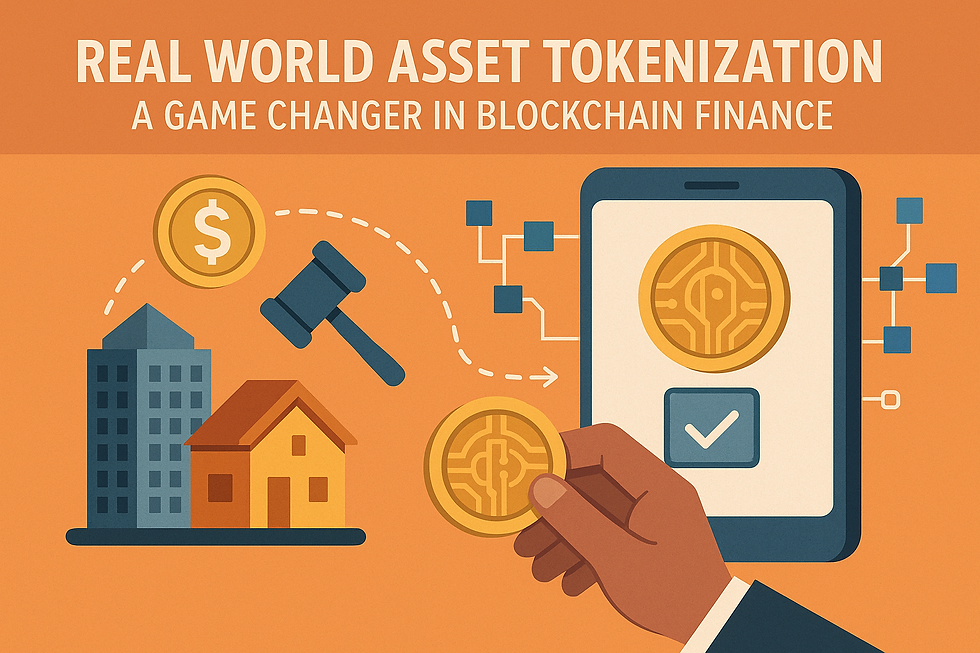Choosing the Best Real World Asset Tokenization Platform for Your Assets
- steveganger
- Oct 14
- 4 min read

Introduction to Real World Asset Tokenization
In the rapidly evolving digital economy, the concept of Real World Asset Tokenization has taken the investment world by storm. With the rise of blockchain technology, traditional assets like real estate, bonds, or commodities can now be represented as digital tokens, enabling fractional ownership and global accessibility. At the center of this revolution lies the Real World Asset Tokenization Platform, the key enabler that makes this entire process possible.
Understanding the Concept of Tokenization
Tokenization is the process of converting rights to a real-world asset into a digital token on the blockchain. These tokens represent ownership, making it easier to transfer, trade, or divide assets securely. Whether it’s a property, a gold reserve, or an art piece — tokenization bridges the physical and digital worlds.
The Rise of Real World Asset Tokenization Platforms
The demand for tokenization platforms has grown exponentially, especially with the increasing need for liquidity, transparency, and inclusivity in financial systems. Businesses and investors alike are recognizing how Real World Asset Tokenization Platforms democratize investment access and open new channels of capital flow.
What is a Real World Asset Tokenization Platform?
A Real World Asset Tokenization Platform is a blockchain-based system that facilitates the digitization of tangible assets. It enables users to create, issue, and manage tokens that represent ownership rights, dividends, or claims over physical or financial assets.
Core Functions of Tokenization Platforms
These platforms typically handle:
Asset registration and verification
Smart contract creation for tokens
Compliance and KYC/AML management
Secondary trading capabilities
Custody and investor management tools
Why Businesses Are Turning to Tokenized Assets
For companies, tokenization offers a new funding model. Instead of relying on traditional banks or venture capital, they can raise funds directly from investors through token issuance — fast, secure, and borderless.
Key Features to Look for in a Real World Asset Tokenization Platform
Choosing the right platform is crucial for a successful tokenization journey. Here’s what to look for:
1. Regulatory Compliance and Legal Framework
The platform must adhere to local and international regulations. Compliance with KYC (Know Your Customer) and AML (Anti-Money Laundering) rules ensures legitimacy and investor protection.
2. Security Protocols and Smart Contract Audits
Security is paramount. Always choose a platform that conducts third-party audits, employs multi-signature wallets, and follows strong encryption standards.
3. Interoperability and Blockchain Compatibility
A powerful tokenization platform should support multiple blockchain networks like Ethereum, Polygon, and Binance Smart Chain to ensure flexibility and scalability.
4. User Experience and Customization
An intuitive dashboard, seamless onboarding, and customizable token features enhance user experience, making the platform more accessible to non-technical investors.
5. Token Standards and Liquidity Options
Look for platforms supporting ERC-20, ERC-1400, or similar token standards — these ensure compatibility with exchanges, wallets, and DeFi protocols, maximizing liquidity potential.
How Real World Asset Tokenization Platforms Unlock Liquidity
Liquidity is one of the biggest challenges in traditional markets, especially for assets like real estate or fine art. Here’s how tokenization solves it.
Tokenization as a Tool for Fractional Ownership
Tokenization allows an asset to be divided into smaller units, letting multiple investors own fractions of it. This approach opens investment opportunities to a larger audience.
Streamlined Access to Global Investors
By eliminating intermediaries, tokenization platforms allow direct participation from global investors, reducing costs and enabling round-the-clock trading opportunities.
24/7 Market Accessibility and Secondary Trading
Unlike conventional markets with fixed hours, Real World Asset Tokenization Platforms enable 24/7 access, giving investors full control over buying or selling assets anytime.
Benefits of Using a Real World Asset Tokenization Platform
Here are the top benefits businesses and investors enjoy:
Transparency and Trust
Blockchain’s immutable nature ensures every transaction is recorded and verifiable, fostering trust between issuers and investors.
Reduced Costs and Improved Efficiency
Smart contracts automate transactions, cutting out middlemen and reducing operational costs significantly.
Enhanced Market Liquidity
Fractional ownership and secondary markets make illiquid assets more liquid, transforming how capital moves in global finance.
Real-World Examples of Tokenization Platforms in Action
Several industries are embracing this technology across diverse asset classes:
Real Estate Tokenization Platforms
Platforms like RealT and RedSwan allow investors to buy fractions of real estate properties, offering steady rental income and capital appreciation.
Commodities and Private Equity Tokenization
Gold and oil tokenization platforms are helping investors gain direct exposure to tangible resources without physical ownership hassles.
Art and Collectibles Tokenization
Luxury art pieces, vintage cars, and rare collectibles are now being tokenized, unlocking new possibilities for asset-backed investments.
Steps to Choose the Right Real World Asset Tokenization Platform
To make an informed decision, follow these steps:
Step 1: Assess Your Asset Type
Different assets require different legal and technical approaches. Choose a platform that specializes in your asset category.
Step 2: Evaluate Legal and Regulatory Support
Ensure the platform operates under a robust legal framework to protect investors and issuers alike.
Step 3: Check Platform Security and Transparency
Look for transparency in token issuance, smart contract audits, and transaction logs.
Step 4: Consider Scalability and Future Growth
Opt for a platform capable of handling future growth, new features, and cross-chain integrations.
Future of Real World Asset Tokenization Platforms
The future is promising for Real World Asset Tokenization Platforms as global adoption accelerates.
Integration with DeFi Ecosystems
DeFi integration will enable tokenized assets to be used in lending, staking, or yield farming — expanding their utility beyond investment.
Institutional Adoption and Regulatory Clarity
As regulations mature, institutional investors will increasingly enter the space, bringing legitimacy and large-scale liquidity.
Conclusion
Real World Asset Tokenization Platforms are reshaping global finance by making asset ownership more democratic, liquid, and transparent. Whether you’re a business seeking capital or an investor looking for new opportunities, the right platform can unlock untapped potential and drive long-term value.
FAQs
1. What is a Real World Asset Tokenization Platform?It’s a blockchain-based platform that digitizes physical or financial assets into tradeable digital tokens.
2. How does tokenization improve liquidity?By enabling fractional ownership and global investor participation, tokenization turns illiquid assets into liquid, tradeable ones.
3. Is tokenization legal?Yes, as long as the platform complies with financial regulations and conducts proper KYC/AML checks.
4. Can small businesses use tokenization platforms?Absolutely! Small and medium enterprises can raise funds globally by tokenizing equity, debt, or real assets.
5. What industries benefit most from tokenization?Real estate, commodities, private equity, and art are currently leading the way in real world asset tokenization adoption.



Comments